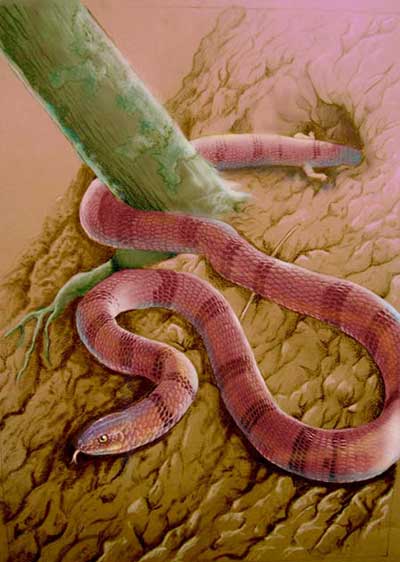Once upon a time, snakes had legs. A recent discovery has revealed that at least one of them had hips. The newly found fossil may help scientists piece together the gaps in the evolutionary history of snakes.
Until now, the prevailing view has been that ancient snakes did not have legs from the moment they slithered from water to land. However, this may not be accurate.

Illustration of Najash, the oldest snake species ever found, crawling on 2 legs and
providing evidence that snakes evolved on land rather than from the sea. (Image: LiveScience)
The newly discovered snake, scientifically named Najash rionegrina, lived about 90 million years ago in Patagonia, Argentina. Scientists excavated it from continental sediment, proving that it lived on land. The creature also shares many skull and vertebral characteristics with modern terrestrial snakes, which are essential for life on land.
“This new organism is further evidence of the terrestrial origins of snakes and eliminates the hypothesis of a link between snakes and extinct marine reptiles known as mosasaurs,” said co-author Hussam Zaher from the Museum of Zoology at the University of São Paulo, Brazil.
Mosasaurs were a type of snake-like reptile that lived underwater and had paddle-like limbs that aided in swimming. Previous hypotheses suggested that snakes emerged when these paddle-like legs disappeared.

Image of the hip region of Najash. The right femur can be seen in the upper part of the image. (Image: LiveScience)
Najash has “outperformed” three marine snake fossils with developed hind limbs – Haasiophis, Pachyrhachis, and Eupodophis – at the base of the snake family tree, making it the most primitive known snake. The other species lack hip bones, and Zaher’s analysis demonstrates that they are more closely related to later-developed snake species.
The current controversy is that the snake has hip bones, meaning it may have been able to use legs for burrowing and slithering. This would lead to a burrowing lifestyle similar to that of modern burrowing snakes. “Morphologically, the legs function completely.” Zaher stated. “However, we cannot be certain how snakes used them.”
Later on, snakes lost their hips and hind legs, becoming more specialized for various terrestrial and aquatic lifestyles.
T. An


















































